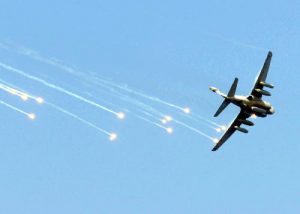Northrop Grumman EA-6B Prowler
Planning an airstrike and need to neutralize enemy air defenses? The U.S. Navy and U.S. Marines have relied on the EA-6B Prowler to do just that for the last 45 years. This long range, all-weather aircraft has the ability to detect, sort, classify, jam, and incapacitate enemy air defense systems, rendering their expensive early warning radar systems useless. As with life, however, all good things must come to an end. The Navy formally retired the Northrop Grumman Prowler in 2015 in favor of the new EA-18G Growler, while the Marines are set to do so in 2019, replacing this capability with a combination of manned and unmanned electronic warfare systems.
Speed
The Prowler cruises over the battlefield at nearly 600 miles per hour clearing the way for airstrikes and ground operations by seeking out and neutralizing enemy radar and communications systems.
Unique Technology
This 4-seat, twin-engine aircraft is one sophisticated machine. Equipped with Northrop Grumman’s state-of-the-art electronic attack system, it devours enemy electronic signals and spits them out for breakfast. By identifying and selectively targeting electronic transmissions across a battlefield, the EA-6B Prowler can monitor and jam signals as needed leaving enemy combatants scratching their heads.
The same technology flying on the Prowler is used by the Navy’s new Growler, making them America’s premier airborne electronic attack weapons.
Cost
Although the EA-6B’s $52M per unit price tag is around $16M less than that of the Growler’s, the costs of sustaining an aging fleet factored into its retirement. Rising maintenance costs combined with high operating costs stemming from fuel inefficiencies and reliance on a 4-member crew doomed the Prowler.

EA-6B Weapons Systems
Prowlers are equipped with a slew of tactical jamming pods, electronic surveillance systems, and other systems used to disable enemy electronic equipment. They also carry radar-seeking HARM missiles for times they need destroy enemy radar antennas and transmitters themselves.
Uses
As part of a carrier air wing, the Prowler’s primary mission is to support surface fleet, strike aircraft, and ground troops in operations around the globe by jamming enemy radar and communications systems. As the saying goes, “no comm, no bomb.” While performing electronic surveillance, the Prowler sweeps the battlefield, pinpoints the location of enemy emitters, and provides situational awareness to commanders and ground troops.
History/Development
The EA-6B Prowler joined the U.S. Navy and Marine Corps fleet in January 1971 and has gone through four major upgrades. The latest upgrade, dubbed Improved Capability (ICAP) III, delivers selective-reactive jamming capability to the warfighter.Since the Prowler’s initial deployment to Southeast Asia in 1972, it has seen combat action around the globe, including Operation Desert Storm, Operation Iraqi Freedom, Libya, and Afghanistan. It has also supported NATO operations in Bosnia-Herzegovina and Yugoslavia.
Read: Four Decades of EA-6B Prowler Service.
Even with retirement looming, the EA-6B Prowler is still a high-demand, low-density military asset used heavily in operations worldwide.
Now see more captivating images of the EA-6B Prowler aircraft!
See EA-6B Prowler Specifications
| Primary Function: Electronic Countermeasures |
| Contractor: Northrop Grumman |
| Date Deployed: First Flight – May 25, 1968; Operational Capability – July 1971 |
| Propulsion: Two Pratt & Whitney J52-P408 engines (10,400 lbs thrust each) |
| Length: 59 ft, 10 in (17.7 m) |
| Height: 16 ft, 8 in (4.9 m) |
| Wingspan: 53 ft (15.9 m) |
| Maximum Take Off Gross Weight: 61,500 lbs (27,450 kg) |
| Airspeed: 500 Kts+ (575 mph, 920 kmh) |
| Ceiling: 37,600 ft |
| Range: 1,000 nm+ (1,150 mi, 1,840 km) |
| Crew: Pilot and three electronic countermeasures officers |

